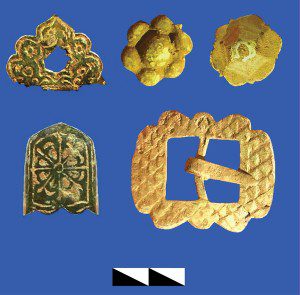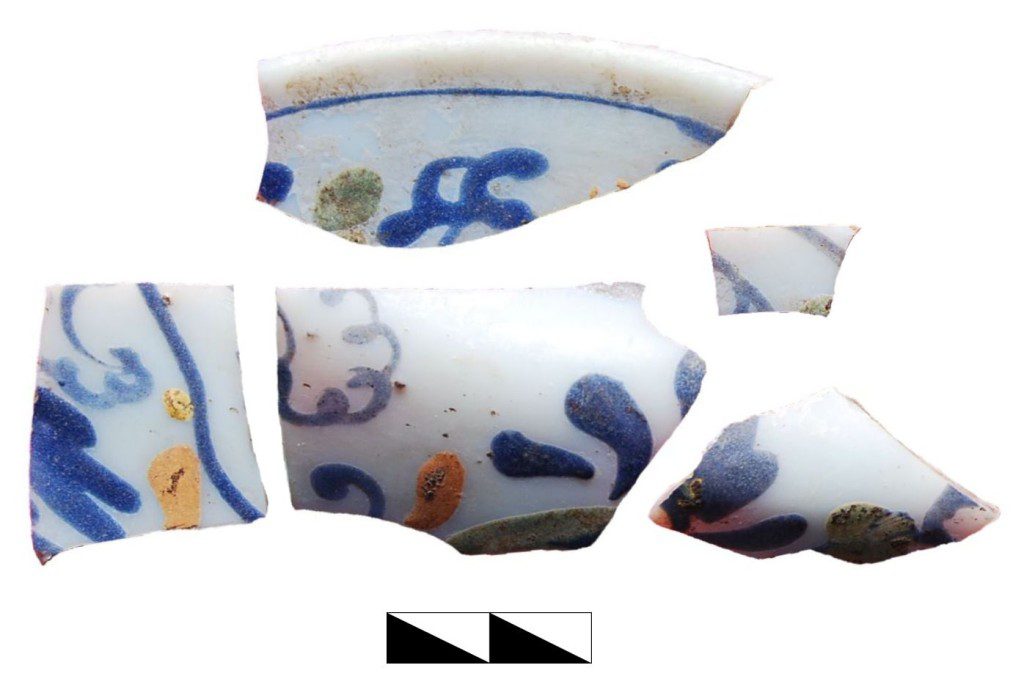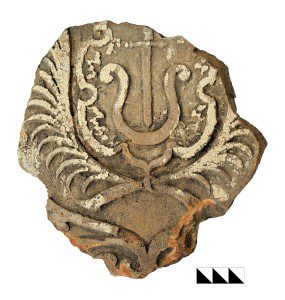(CIUS: Edmonton-Toronto) In 2014, the Canada-Ukraine archaeological expedition continued excavating the remnants of Hetman Ivan Mazepa's main residence in Baturyn. Prior to 1700, he constructed a richly embellished brick baroque palace that was burned by Russian troops during their destruction of the town in 1708.
Many fragments of fine multicoloured glazed and terracotta floor, stove, and façade revetment tiles were found. These decorative details of Mazepa's villa represent the seventeenth-century Kyivan school of architectural majolica.
Researchers have prepared computer reconstructions of nine ornamental floor pavement patterns of the palace's reception halls, living quarters, and office premises. Of all the known early modern buildings in Ukraine, Mazepa's principal residence in Baturyn stands out for the largest number, variety, and distinctive features of decorative types of ceramic floor tiles and pavement methods. This attests to its comparatively large size, multistoried and multi-chamber architectural design, and exceptional embellishment.
Fragments of costly milk-glass plates painted with multicoloured plant design, seventeenth or eighteenth century.
2014 excavations in the Baturyn fortress. Photo: Yu. Sytyi
Archaeologists have completed excavating the remnants of the spacious service structure at Mazepa's court. It probably housed either members of the hetman's guard or Cossack officers from his retinue. The following items were found at this site in 2014: seventeenth- and eighteenth-century Polish and Russian silver and copper coins; locally produced bronze buttons; a clasp and four figured appliqués with relief patterns and engravings that adorned the costly leather belts of officers; lead musket bullets; and fragments of imported German glazed tableware and Dutch porcelain tobacco pipes. Using computer techniques, investigators have reconstructed three decorated belts of wealthy Cossack officers.
Among the service structure's debris and within the Baturyn fortress, many shards of delicate milk-glass plates painted with floral motifs were discovered. These were likely brought to early modern Baturyn from the Ottoman Porte. Finds of imported goods indicate the trade connections of the Cossack capital with Northern, Central, and Eastern Europe and the Islamic East
.
Fragments of costly milk-glass plates painted with multicoloured plant design, seventeenth or eighteenth century.
2014 excavations in the Baturyn fortress. Photo: Yu. Sytyi
In the Baturyn suburb of Ostroh, a ceramic stove tile bearing the relief coat of arms of Pylyp Orlyk, a future émigré hetman and author of the first Ukrainian constitution (1710), was discovered. Archaeologists hope to locate the remnants of Orlyk's residence at the site where this heraldic tile was found.
In the fortress, ten seventeenth- and eighteenth-century graves of burghers were exhumed in 2014. Three of them can be identified as victims of the Russian assault on Baturyn
The excavations of 2014 in Baturyn have yielded important data for research and reconstruction of the architecture and decoration of hetman residences as well as the accoutrement of Cossack officers. New archaeological finds testify to the vibrancy of grain agriculture, crafts, and applied arts as well as international commercial and cultural contacts of the town before the 1708 onslaught.
Broken ceramic heraldic stove tile found in the suburb of Ostrih in 2014.
Baturyn Museum of Archaeology. Photo: T. Kerbut.
CIUS, the Pontifical Institute of Mediaeval Studies (PIMS), and the Ucrainica Research Institute in Toronto sponsor the Baturyn project. Professor Zenon Kohut (CIUS) is its academic leader. Dr. Volodymyr Mezentsev (CIUS) and Professor Martin Dimnik (PIMS) participate in this research and the dissemination of its results. Nearly 50 students and scholars from universities in Chernihiv, Kyiv, and Hlukhiv took part in the excavations.
The Mazepa and Rozumovsky Palaces in Baturyn
Zenon Kohut, Volodymyr Mezentsev et al., Arkheolohichni doslidzhennia u Baturyni 2013-2014 rr. Palatsy Ivana Mazepy ta Kyryla Rozumovskoho. Do 70-littia profesora Zenona Kohuta (Archaeological Research in Baturyn 2013-2014. Palaces of Ivan Mazepa and Kyrylo Rozumovsky. In commemoration the 70th birthday of Professor Zenon Kohut), Toronto, 2015, 32 pp., 79 colour illustrations.
This is the fourth richly illustrated booklet presenting the work of Canadian and Ukrainian archaeologists and historians researching Baturyn, the capital of the Cossack state. CIUS is the main sponsor of this project. The publication surveys the history of Baturyn during its golden age under Hetman Ivan Mazepa and the destruction of the town by Russian troops in 1708 and subsequent rebuilding by Hetman Kyrylo Rozumovsky. The sack of Baturyn is described using the 18th-century French sources and the Cossack chronicle.
The authors discuss the results of the 2013-14 Canada-Ukraine excavations at the fortress and hetman estates. They examine the remnants of the palatial residences of Mazepa and Rozumovsky and present computer reconstructions of their architecture and decoration. Archaeological findings testify to the dynamic international trade, crafts, agriculture, and artistic development in Baturyn before 1708.
The booklet is available from CIUS Press for $8.95 (paperback).


